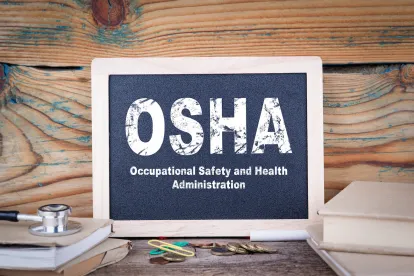The U.S. government recently reminded employers that the consequences stemming from worker safety violations are not limited to civil monetary penalties and specific hazard abatement requirements levied by the Occupational Safety and Health Administration (OSHA). They can lead to criminal liability under the Occupational Safety and Health Act (OSH Act) as well.
Specifically, on November 24, 2020, a U.S. Attorney in the Western District of Pennsylvania filed a criminal charge against a Pennsylvania construction contractor due to the contractor’s alleged failure to protect a worker from hazards associated with trenches. OSHA issued the construction contractor a “willful” citation in November 2017, following a May 2017 accident in which a worker died during a trench collapse. The employer is contesting the underlying OSHA citation and associated civil penalties, but the criminal charge was brought despite those ongoing contest proceedings.
Chapter 15 of OSH Act, 29 U.S.C. § 666(e), generally creates a criminal penalty[1] against “any employer who willfully violates” an OSHA standard and an employee dies as a result. Employers should remember though that OSHA’s mere issuance of a “willful” citation following an employee fatality is not sufficient to establish criminal liability because the willfulness of the alleged violation must still be proven “beyond a reasonable doubt” in the criminal proceedings, along with the other necessary elements. But if proven, the employer may be fined and / or face imprisonment.
Willful violations issued by OSHA can wreak havoc on employers’ businesses—particularly in the construction industry where general contractors may look at the safety history of subcontractors who bid on projects. Add prior criminal allegations or penalties on top of that, and construction industry employers could fold when faced with this challenge.
Accordingly, at a minimum, employers should generally do the following to minimize the risks of these adverse consequences when OSHA comes knocking:
-
Regularly review and revise operating procedures and safety manuals to ensure they are up-to-date with current operations and protocols. Many employers use template operations or safety manuals that do not address the employers’ actual operations and associated hazards. This problem can lead to confusion among workers and cause accidents or near-misses in the workplace—as well as lead an OSHA investigator later to question an employer’s credibility when it says it cares about worker safety.
-
Promptly and fully address all known or obvious workplace hazards. OSHA defines a “willful” violation as one “in which the employer either knowingly failed to comply with a legal requirement (purposeful disregard) or acted with plain indifference to employee safety.” Thus, if an employer ignores a known hazard and an employee dies as a result of it, it could face criminal penalties under the OSH Act.
-
Similar to the above consideration, promptly and fully address all employee safety complaints and concerns. Employees are uniquely knowledgeable about the hazards associated with their job duties, so employers are well-advised to take their complaints and concerns seriously and document any resulting actions or remedial measures taken. Certainly, not all employee complaints and concerns require an actual change or remedial measure, but employers who ignore valid employee safety concerns may be tagged with a “willful” OSHA citation when an issue does arise.
-
Train company management on how to handle OSHA inspections and investigations—before OSHA comes knocking. Managers’ admissions to OSHA inspectors may be attributable to and therefore bind the employer. Thus, if a manager makes a statement to an OSHA inspector that can be construed as an admission that he / she had knowledge of the hazard at issue, it could lead to a determination that the employer itself had knowledge and therefore a “willful” citation.
-
Be sure to involve senior management and / or appropriate legal counsel, if OSHA shows up for an inspection or investigation. Under the OSH Act, employers are entitled to a company representative and an attorney of their choosing during OSHA investigations (except during non-managerial employee OSHA interviews). And they are well-advised to exercise these rights to ensure its interests are represented properly.
These steps will go a long way to providing a safe workplace for employees—and to managing the risks associated with OSHA inspections.
[1] To be sure, the OSH Act creates criminal liability for other employer actions as well (e.g., making false statements to OSHA), but this blog post focuses on criminal consequences for willful violations leading to employee fatalities.




 />i
/>i

